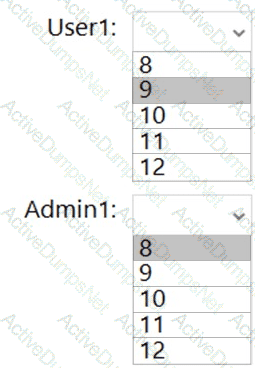Microsoft AZ-801 Configuring Windows Server Hybrid Advanced Services Exam Practice Test
Configuring Windows Server Hybrid Advanced Services Questions and Answers
You are remediating the firewall security risks to meet the security requirements.
What should you configure to reduce the risks?
You need to implement a security policy solution to authorize the applications. The solution must meet the security requirements.
Which service should you use to enforce the security policy, and what should you use to manage the policy settings? To answer, select the appropriate options in the answer area.
NOTE: Each correct selection is worth one point.
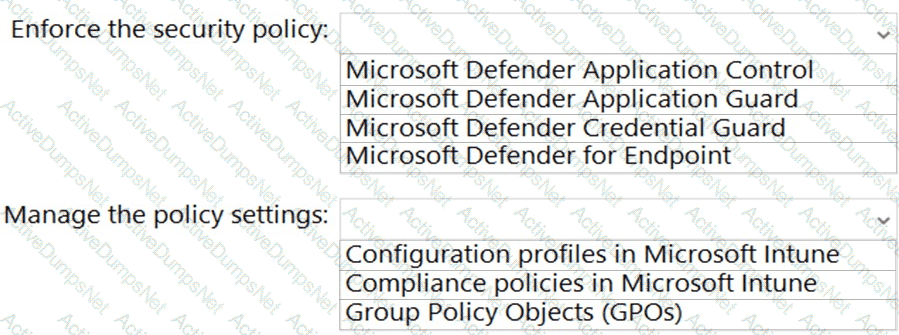
You are planning the migration of Archive1 to support the on-premises migration plan.
What is the minimum number of IP addresses required for the node and cluster roles on Cluster3?
You are planning the europe.fabrikam.com migration to support the on-premises migration plan-Where should you install the Password Export Server (PES) service, where should you generate the encryption key? To answer, select the appropriate options in the answer area.
NOTE: Each correct selection is worth one point.

You are planning the data share migration to support the on-premises migration plan.
What should you use to perform the migration?
You are planning the implementation of Cluster2 to support the on-premises migration plan.
You need to ensure that the disks on Cluster2 meet the security requirements.
In which order should you perform the actions? To answer, move all actions from the list of actions to the answer area and arrange them in the correct order.

You are planning the www.fabrikam.com website migration to support the Azure migration plan.
How should you configure WebApp1? To answer, select the appropriate options in the answer area.
NOTE: Each correct selection is worth one point.

You are planning the migration of APP3 and APP4 to support the Azure migration plan.
What should you do on Cluster1 and in Azure before you perform the migration? To answer, select the appropriate options in the answer area.
NOTE: Each correct selection is worth one point.
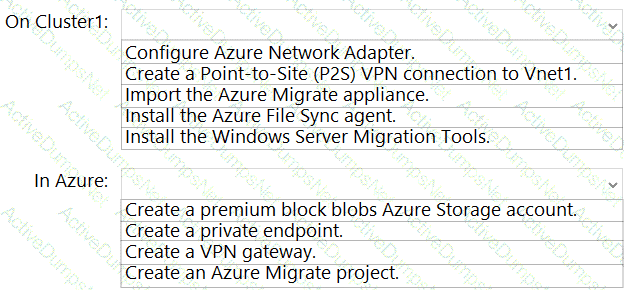
You are planning the deployment of Microsoft Sentinel.
Which type of Microsoft Sentinel data connector should you use to meet the security requirements?
You are planning the DHCP1 migration to support the DHCP migration plan.
Which two PowerShell cmdlets should you run on DHCP1, and which two PowerShell cmdlets should you run on DHCP2? To answer, drag the appropriate cmdlets to the correct servers. Each cmdlet may be used once, more than once, or not at all. You may need to drag the split bar between panes or scroll to view content.
NOTE: Each correct selection is worth one point.

For each of the following statements, select Yes if the statement is true. Otherwise, select No.
NOTE: Each correct selection is worth one point.

You need to implement alerts for the domain controllers. The solution must meet the technical requirements.
What should you do on the domain controllers, and what should you create on Azure? To answer, select the appropriate options in the answer area.
NOTE: Each correct selection is worth one point.

You need to meet the technical requirements for Cluster2.
Which four actions should you perform in sequence before you can enable replication? To answer, move the appropriate actions from the list of actions to the answer area and arrange them in the correct order.

You need to configure BitLocker on Server4.
On which volumes can you turn on BitLocker, and on which volumes can you turn on auto-unlock? To answer, select the appropriate options in the answer area.
NOTE: Each correct selection is worth one point.

With which servers can Server1 and Server3 communicate? To answer, select the appropriate options in the answer area.
NOTE: Each correct selection is worth one point.
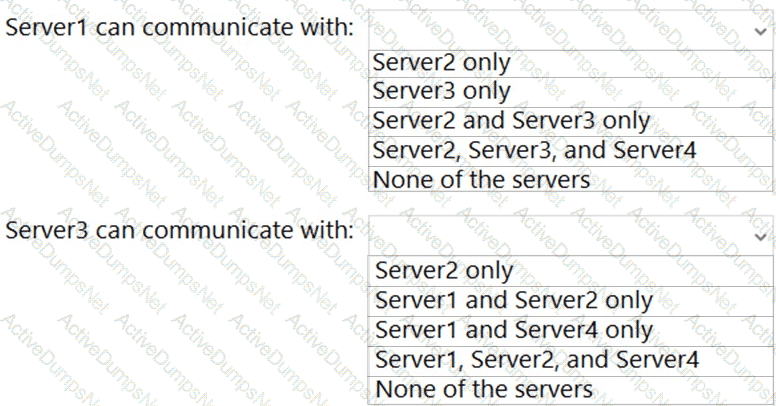
You need to meet technical requirements for Share1.
What should you use?
You need to back up Server 4 to meet the technical requirements.
What should you do first?
You need to meet the technical requirements for Cluster3.
What should you include in the solution?
You are evaluating the technical requirements tor Cluster2.
What is the minimum number of Azure Site Recovery Providers that you should install?
Which domain controller should be online to meet the technical requirements for DC4?
You need to meet the technical requirements for User1.
To which group in contoso.com should you add User1?
What is the effective minimum password length for User1 and Admin1? To answer, select the appropriate options in the answer area.
NOTE: Each correct selection is worth one point.
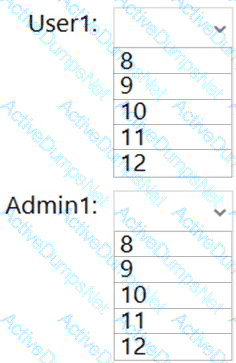
You have an on-premises server that runs Windows Server and has the Web Server (IIS) server role installed. The server hosts a web app that connects to an on-premises Microsoft SQL Server database.
You plan to migrate the web app to an Azure App Services web app. The database will remain on-premises.
You need to ensure that the migrated web app can access the database.
What should you configure in Azure?
Your network contains an Active Directory Domain Services (AD DS) domain. The domain contains servers that run Windows Server 2022.
You have a Storage Spaces Direct cluster named SSCIuster1 that contains two physical nodes named Node! and Node2. Node! and Node2 host highly available virtual machines.
You plan to perform an in-place upgrade to Windows Server 2025 on Node1
You need to ensure that the virtual machines remain running during the upgrade.
Which four actions should you perform in sequence on Node1? To answer, move the appropriate actions from the list of actions to the answer area and arrange them in the correct order.

You have an Azure subscription that has Microsoft Defender for Cloud enabled.
You have 50 Azure virtual machines that run Windows Server.
You need to ensure that any security exploits detected on the virtual machines are forwarded to Defender for Cloud.
Which extension should you enable on the virtual machines?
Your network contains an Active Directory Domain Services (AD DS) forest. The forest contains the domains shown in the following table.

You are implementing Microsoft Defender for Identity sensors.
You need to install the sensors on the minimum number of domain controllers. The solution must ensure that Defender for Identity will detect all the security risks in both the domains.
What should you identify? To answer, select the appropriate options in the answer area.
NOTE: Each correct selection is worth one point.














